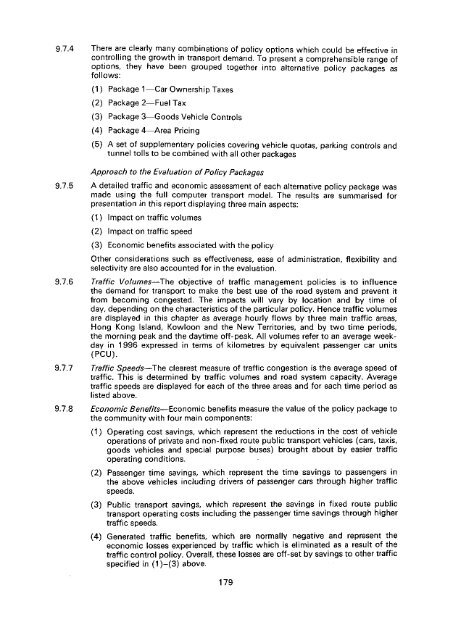Untitled - HKU Libraries - The University of Hong Kong
Untitled - HKU Libraries - The University of Hong Kong
Untitled - HKU Libraries - The University of Hong Kong
- No tags were found...
You also want an ePaper? Increase the reach of your titles
YUMPU automatically turns print PDFs into web optimized ePapers that Google loves.
9.7.4 <strong>The</strong>re are clearly many combinations <strong>of</strong> policy options which could be effective incontrolling the growth in transport demand. To present a comprehensible range <strong>of</strong>options, they have been grouped together into alternative policy packages asfollows:(1) Package 1—Car Ownership Taxes(2) Package 2—Fuel Tax(3) Package 3—Goods Vehicle Controls(4) Package 4—Area Pricing(5) A set <strong>of</strong> supplementary policies covering vehicle quotas, parking controls andtunnel tolls to be combined with all other packagesApproach to the Evaluation <strong>of</strong> Policy Packages9.7.5 A detailed traffic and economic assessment <strong>of</strong> each alternative policy package wasmade using the full computer transport model. <strong>The</strong> results are summarised forpresentation in this report displaying three main aspects:(1) Impact on traffic volumes(2) Impact on traffic speed(3) Economic benefits associated with the policyOther considerations such as effectiveness, ease <strong>of</strong> administration, flexibility andselectivity are also accounted for in the evaluation.9.7.6 Traffic Volumes—<strong>The</strong> objective <strong>of</strong> traffic management policies is to influencethe demand for transport to make the best use <strong>of</strong> the road system and prevent itfrom becoming congested. <strong>The</strong> impacts will vary by location and by time <strong>of</strong>day, depending on the characteristics <strong>of</strong> the particular policy. Hence traffic volumesare displayed in this chapter as average hourly flows by three main traffic areas,<strong>Hong</strong> <strong>Kong</strong> Island, Kowloon and the New Territories, and by two time periods,the morning peak and the daytime <strong>of</strong>f-peak. All volumes refer to an average weekdayin 1996 expressed in terms <strong>of</strong> kilometres by equivalent passenger car units(PCU).9.7.7 Traffic Speeds—<strong>The</strong> clearest measure <strong>of</strong> traffic congestion is the average speed <strong>of</strong>traffic. This is determined by traffic volumes and road system capacity. Averagetraffic speeds are displayed for each <strong>of</strong> the three areas and for each time period aslisted above.9.7.8 Economic Benefits—Economic benefits measure the value <strong>of</strong> the policy package tothe community with four main components:(1) Operating cost savings, which represent the reductions in the cost <strong>of</strong> vehicleoperations <strong>of</strong> private and non-fixed route public transport vehicles (cars, taxis,goods vehicles and special purpose buses) brought about by easier trafficoperating conditions.(2) Passenger time savings, which represent the time savings to passengers inthe above vehicles including drivers <strong>of</strong> passenger cars through higher trafficspeeds.(3) Public transport savings, which represent the savings in fixed route publictransport operating costs including the passenger time savings through highertraffic speeds.(4) Generated traffic benefits, which are normally negative and represent theeconomic losses experienced by traffic which is eliminated as a result <strong>of</strong> thetraffic control policy. Overall, these losses are <strong>of</strong>f-set by savings to other trafficspecified in (1)-(3) above.179
















